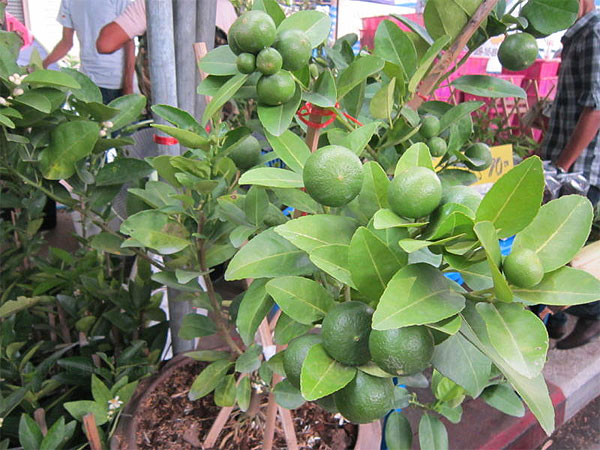The recently concluded agricultural fair at Kasetsart University might not be the much-awaited event it used to be for agriculturists and fair-goers from all over the country. However, I go every year anyway as there are always new plants to see. Lek Monchai’s lime hybrid, for example, was not even registered. Making its debut at the fair, he had not even decided what to name it.

In demand: Below, for gardeners, the main attractions of the annual Kaset Fair are new hybrids.
A female relative successfully developed it in their Min Buri orchard, using pomelo as stock. "It has lots of fruit, and is very resistant to diseases," he said. He would not part with the 70cm fruit-laden specimen on show to give buyers an idea of what the new hybrid is like, but smaller saplings, already bearing flowers, were available for 150 baht each.
The plant sellers are also nursery owners themselves, so there is always a chance to hear how to grow fruit trees and flowers successfully straight from the horse’s mouth. When there are no buyers around to keep them busy, they are generous with their time, even when the plants one is asking about did not come from them.
Shortly before the fair, Tony Robbins sent me an email from Banglamung, just outside Pattaya, wondering why his lemons were not bearing fruit. “For the first two years they went well, flowering and bearing fruit,” he wrote. “Then they just stopped, with little new foliage and no flowers or fruit. They get adequate water and I feed them with a handful of 16-16-16 or 9-24-24 fertiliser every four to six weeks and, when available, old cow manure."
If they are getting enough water and nutrients, what then could have gone wrong with Mr Robbins’ lemon trees? Mr Lek and another nursery owner, Tukata Kiranyakocharoen, who grows limes and lemons in Ram Intra 46, were a block away from each other at the fair, yet their answers were the same when I asked them that same question.

Disease resistant: A prolific hybrid developed in a Min Buri orchard, this lime made its debut at the Kaset Fair.
“It has something to do with the age of the tree and the variety,” they agreed. “Trees grown from seed begin to flower after five to six years, and grafted trees two to three years. Some varieties are by nature more prolific than others. But if trees had been bearing fruit and then stopped, something must be wrong with the soil, or it could be due to too much water.”
Limes and lemons have the same cultural requirements, the experts said. Both thrive best in full sun and can grow in any kind of soil, but perform best in a well-drained, sandy or clay loam soil rich in organic matter. Their advice was for Mr Robbins to prune his trees so that they do not look straggly and to encourage new growth; improve the soil; and water just enough to keep the soil moist.
Lemon trees respond well to pruning, and removing dead wood and some branches where they join the trunk will produce an open, airy tree and invigorate the remaining shoots. Cutting the tip of the top branch will result in vigorous growth of dormant buds just below the cut and produce a more bushy and compact plant.
The soil can be improved by mixing it with organic matter like leaf mould and well decomposed animal manure. As the matter decomposes, it not only provides nutrients for the plants but also improves microbial activity and the physical structure of the soil. Organic fertiliser contains macronutrients (nitrogen, phosphorus and potassium) as well as trace elements (such as boron), which plants equally need for growth and development. Be careful, however, not to sever the roots when cultivating the soil around the trees.

Keeping them contained: Watering is easier to control if lemon trees are grown in pots.
Organic fertiliser should be enough to sustain Mr Robbins’ trees for the time being. He would know he had done the right thing if new leaves emerged after he has pruned his trees and improved the soil. If not, his problem could be due to over-watering.
Lack of water causes the flowers to drop, but soggy soil also produces the same results. In his email to me, Mr Robbins admitted that watering was sometimes hard to control since he has a lawn sprinkler system that is on for five minutes each day, except in the rainy season when it is turned off. “The trees are maybe over-watered but the soil is damp, not wet,” he said.
He added that the trees are in concrete rings above the soil surface, so if the trees do not improve that is probably where his problem lies. The concrete pavement around the trees prevents water evaporation. The soil under the surface, therefore, is always soggy, depriving the trees of oxygen. If he cannot control the watering, the best bet for Mr Robbins is to transplant his trees in containers, using the same potting material as above.
A standard practice among commercial growers of citrus fruits is to induce their trees to bear flowers by suspending water for 10-14 days until the leaves begin to wilt. They then give the trees fertiliser high in phosphorus and potassium, like Mr Robbins’ NPK 9-24-24, before irrigating them thoroughly. Regular watering is resumed, and fertiliser applied every two weeks. Flowers begin to emerge two weeks later, and fruit can be harvested six months after flowering.
Most citrus trees are self-pollinating, but heavier yields can be obtained if there are insect pollinators in the area. n
Email nthongtham@gmail.com.
